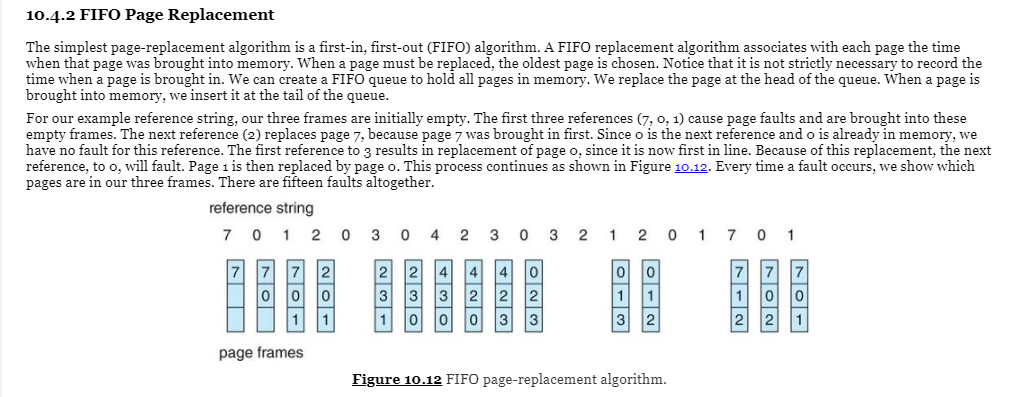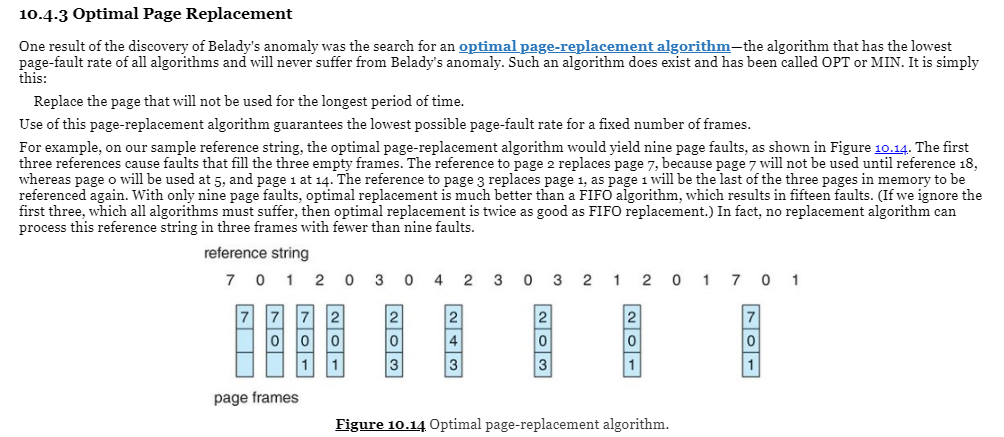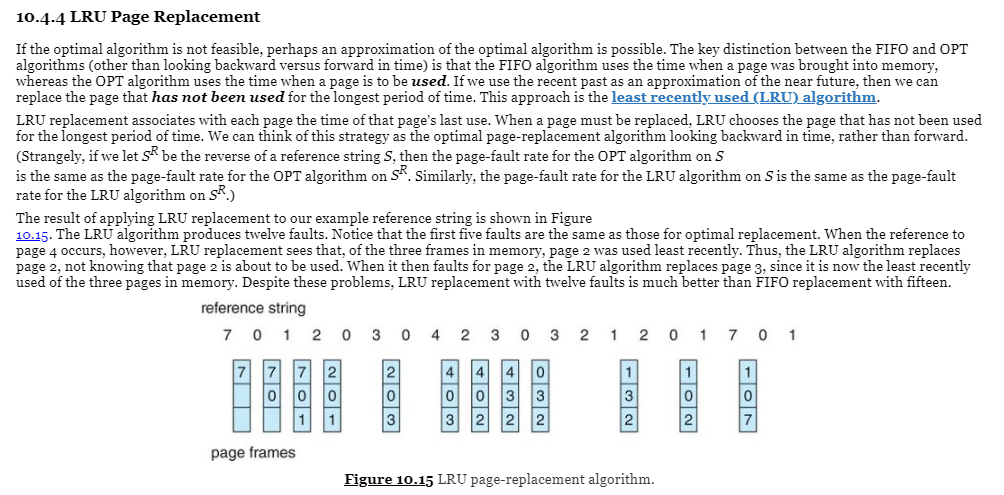In C program
Write a program that implements the FIFO LRU, and optimal (OPT) page-replacement algorithms presented in Section 10.4. Have your program initially generate a random page-reference string where page numbers range from 0 to 9. Apply the random page-reference string to each algorithm, and record the number of page faults incurred by each algorithm. Pass the number of page frames to the program at startup. You may implement this program in any programming language of your choice. (You may find your implementation of either FIFO or LRU to be helpful in the virtual memory manager programming project.)



10.4.2 FIFO Page Replacement The simplest page-replacement algorithm is a first-in, first-out (FIFO) algorithm. A FIFO replacement algorithm associates with each page the time when that page was brought into memory. When a page must be replaced, the oldest page is chosen. Notice that it is not strictly necessary to record the time when a page is brought in. We can create a FIFO queue to hold all pages in memory. We replace the page at the head of the queue. When a page is brought into memory, we insert it at the tail of the queue. For our example reference string, our three frames are initially empty. The first three references (7, 0, 1) cause page faults and are brought into these empty frames. The next reference (2) replaces page 7, because page 7 was brought in first. Since o is the next reference and o is already in memory, we have no fault for this reference. The first reference to 3 results in replacement of page o, since it is now first in line. Because of this replacement, the next reference, to o, will fault. Page 1 is then replaced by page o. This process continues as shown in Figure 10.12. Every time a fault occurs, we show which pages are in our three frames. There are fifteen faults altogether. reference string 7 0 2 0 3 0 2 3 2 1 2 0 1 7 1 4 0 3 0 1 7 2 o o 17 NOD own o 1 0 0 2 2 2 1 page frames Figure 10.12 FIFO page-replacement algorithm. 10.4.3 Optimal Page Replacement One result of the discovery of Belady's anomaly was the search for an optimal page-replacement algorithm the algorithm that has the lowest page-fault rate of all algorithms and will never suffer from Belady's anomaly. Such an algorithm does exist and has been called OPT or MIN. It is simply this: Replace the page that will not be used for the longest period of time. Use of this page-replacement algorithm guarantees the lowest possible page-fault rate for a fixed number of frames. For example, on our sample reference string, the optimal page-replacement algorithm would yield nine page faults, as shown in Figure 10.14. The first three references cause faults that fill the three empty frames. The reference to page 2 replaces page 7, because page 7 will not be used until reference 18, whereas page o will be used at 5, and page 1 at 14. The reference to page 3 replaces page 1, as page 1 will be the last of the three pages in memory to be referenced again. With only nine page faults, optimal replacement is much better than a FIFO algorithm, which results in fifteen faults. (If we ignore the first three, which all algorithms must suffer, then optimal replacement is twice as good as FIFO replacement.) In fact, no replacement algorithm can process this reference string in three frames with fewer than nine faults. reference string 7 0 1 2 03 0 4 2 3 0 3 2 1 2 0 1 7 0 1 2 2 7772 0 0 7 10 0 0 0 3 1 page frames Figure 10.14. Optimal page-replacement algorithm. 10.4.4 LRU Page Replacement If the optimal algorithm is not feasible, perhaps an approximation of the optimal algorithm is possible. The key distinction between the FIFO and OPT algorithms (other than looking backward versus forward in time) is that the FIFO algorithm uses the time when a page was brought into memory, whereas the OPT algorithm uses the time when a page is to be used. If we use the recent past as an approximation of the near future, then we can replace the page that has not been used for the longest period of time. This approach is the least recently used (LRU) algorithm. LRU replacement associates with each page the time of that page's last use. When a page must be replaced, LRU chooses the page that has not been used for the longest period of time. We can think of this strategy as the optimal page-replacement algorithm looking backward in time, rather than forward. (Strangely, if we let SR be the reverse of a reference string S, then the page-fault rate for the OPT algorithm on S is the same as the page-fault rate for the OPT algorithm on S. Similarly, the page-fault rate for the LRU algorithm on Sis the same as the page-fault rate for the LRU algorithm on SR) The result of applying LRU replacement to our example reference string is shown in Figure 10.15. The LRU algorithm produces twelve faults. Notice that the first five faults are the same as those for optimal replacement. When the reference to page 4 occurs, however, LRU replacement sees that of the three frames in memory, page 2 was used least recently. Thus, the LRU algorithm replaces page 2, not knowing that page 2 is about to be used. When it then faults for page 2, the LRU algorithm replaces page 3, since it is now the least recently used of the three pages in memory. Despite these problems, LRU replacement with twelve faults is much better than FIFO replacement with fifteen. reference string 70 1 20 30 4 2 3 0 3 2 1 201701 1 1 4 4 4 0 0 0 3 3 3 2 2 2 3 0 2 2 7 page frames Figure 10.15 LRU page-replacement algorithm









